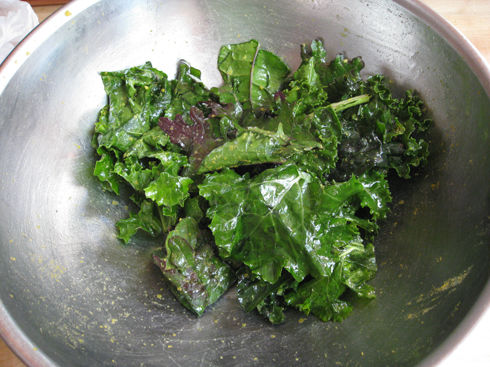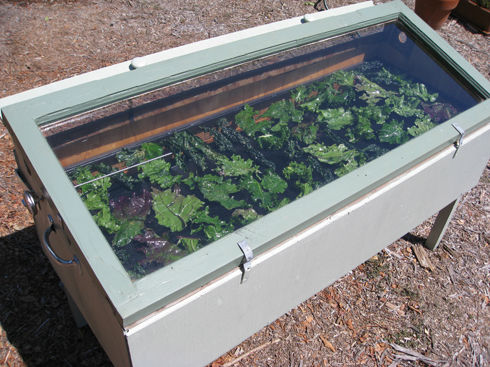Sunny days mean that it’s time for a little solar food drying. Add an overabundance of kale and you’ve got a formula for a tasty snack: Kale Chips
We pulled out the solar food dryer that we built last year and started warming it in the sun. Before long it was up to 110º inside and ready for a batch of kale chip. Here’s the recipe we used:

Crispy Kale Chips
Serves 4
- 1 12-oz. bunch curly kale, center
- stems removed, each leaf torn
- into 4 pieces (6 cups)
- 2 Tbs. olive oil
- 1 Tbs. lemon juice
- 1/2 tsp. sea salt
- 3 Tbs. nutritional yeast
Directions
1. Place kale in bowl. Rub oil, lemon juice, and salt into leaves with hands. Add nutritional yeast, and toss well.
2. Spread kale onto dehydrator trays without overlapping. Dehydrate 2
to 4 hours, or until dry and crispy. Turn off dehydrator, and cool
completely.
*Since our dehydrator is solar, we weren’t sure how much time it would take, but we assumed that 2 to 4 hours was a good guideline.
We layered the kale pieces on the screen and put them out in the dryer.

kale chips drying with sun power
We had more kale than room on the screen, so we fired up the oven to 350º and put the rest on cookie sheets in a single layer. We baked them for 10 minutes until crisp.
The oven chips obviously finished first and the results were delicious! We ate them over the sink (it’s like eating crumbly tissue paper, with much better flavor). A couple hours later the solar chips were done. Well, almost.
Maybe it’s because they weren’t completely dry (still a little bit chewy), or maybe we didn’t have the heat high enough (it can be regulated by opening the vent door), but the kale chips made in the food dryer came out bitter. In talking with a professional who has a vegan raw kale chip business, he said he has experienced bitter chips when they don’t completely dry during the process. So we’ll try again and leave them in longer.
Oven or solar food dryer – either way, we’ve got plenty of kale to keep trying until we get it right. Trial and error never tasted so good!




Hmm.. sounds new to my ear. 🙂 Maybe I will give it a try! Maybe you could do a follow up on this topic so that I can introduce it to my friends.
Garlic cloves yielded very hard yellow ‘stones’ which we stored ‘as is’, for later grinding into very potent garlic powder. ( use a coffee bean grinder,found for cheap, at a ‘yard sale’, set aside for only that purpose, and some elbow grease to do the job) Powder does not store well, takes on moisture easily!
Also stored butter-nut squash, by washing them well in ‘javex’, placing them on shelf wet, never touching them again until day used. They lasted even up to 8 months, or until weather got too warm, here in Canada, just north of Toronto. Still drinking tomato juice from 3 years ago, a ‘bumper crop’ like never before! Pressure-canned them, into glass jars, according to instructions on net, never regretted preserving that wonderful bounty! Son makes wonderful rhubarb, sparking wines, they keep very long, if fermented, bottled, correctly. Rhubarb very plentiful here, but must pay cash for the sugar, dammit! Beer, on the other hand, from grain, very pure, good for up to 2 years in bottles in a cool dark place, even gets better as time passes, never lasted longer than 2 years around here, so that is all we can claim! Pressure canned a bounty crop of green beans, ate them for three years! We use, but resent the electric bills on freezers, try to avoid them for this reason! Practical survivors to our very souls! Hope we(my wife and I) have served, helped in some way here. God bless!
Wow, even worked with garlic? I’m so glad to hear that. Apparently you can dehydrate kale without all the flavorings and oil. Just follow these instructions here and you’ll be on your way:
https://ezinearticles.com/?How-to-Dehydrate-Kale&id=4595522
Kale! So abundant! So fragile! Can it be dried without oils, flavorings, for storage, for the winter months? I dried oregano, basil,carrots, onion tops, even celery greens this way, very dry, then shelved in brown paper bags, on a high dry shelf. They make wonderful additions to winter soups, and hopefully still have enough vitamins to count as health-giving. Did surplus garlic this way too, even potato scallops, dipped in ascorbic acid solution for ‘whiteness’, dried, stored up to two years, still good, still re-hydrated for wonderful scalloped potato dishes.